A deep look at Caterpillar’s approach to technology
29 March 2022
ACE at work: CTO Karl Weiss talks about the integration of autonomy, connectivity and electrification
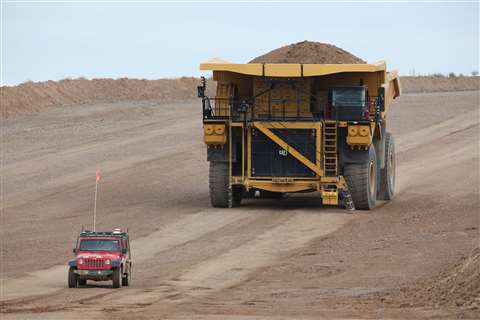 The 794 AC has become the latest Cat haul truck to be equipped with an autonomous hauling solution, MineStar Command for hauling. (Photo: Caterpillar)
The 794 AC has become the latest Cat haul truck to be equipped with an autonomous hauling solution, MineStar Command for hauling. (Photo: Caterpillar)
Caterpillar’s Technical Center in Mossville, Ill., is bustling. A decade ago, when engineering teams there worked 24/7 to ensure the company’s engines and equipment met engine emissions regulations, the halls and parking lots of its research and development hub were full. They are somewhat quieter today — the pandemic era hybrid office arrangements have employees, whenever possible, working from home — but the work continues at Mossville and around the world.
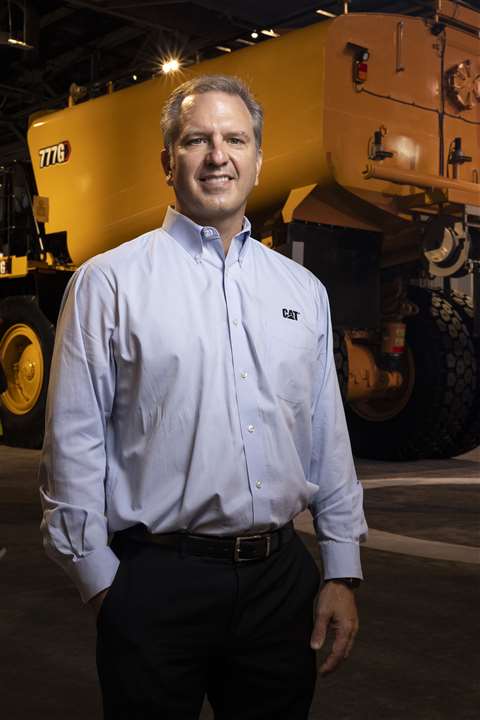 “Those are the quick wins customers can achieve with autonomy, but with the processes we help them put in place, they can also drive consistency just like we do in our Caterpillar factories.” Karl Weiss, CTO, Caterpillar. (Photo: Caterpillar)
“Those are the quick wins customers can achieve with autonomy, but with the processes we help them put in place, they can also drive consistency just like we do in our Caterpillar factories.” Karl Weiss, CTO, Caterpillar. (Photo: Caterpillar)
For more than a century, Caterpillar has developed equipment with the latest technology to help customers complete their work regardless of what’s happening in the world. At the same time, the company has made continuous improvements with its own internal systems and processes.
“Today we’re better able to develop products with teams from Peoria to Bangalore,” said Karl Weiss, the company’s Chief Technology Officer since 2019 and a vice president with responsibility for the company’s Integrated Components and Solutions Division. “We have equipment for software-in-the-loop and hardware-in-the-loop testing. We have identical virtual proving grounds in Peoria, Tucson, Brisbane and Bangalore, where our engineers can run tests from anywhere in the world on a 24-hour basis. Teams are always working because a lot of the simulations we run take time to complete. Because we can run those tests around the clock, we’ve become more productive and our teams have become more experienced.
“Work at the Technical Center starts with a deep understanding of our customers’ challenges. I like to make sure our new engineers know we’re not developing technology for technology’s sake.”
While it continues to develop new internal combustion engine technology, Caterpillar’s physical and virtual labs are focused on ACE, an acronym for automation, connectivity and electrification.
“We always talk about those three together because our customers can get the most out of the technology when they are combined,” said Weiss.
Smart creep
Some of the results of that work was displayed in the company’s World of Concrete booth in Las Vegas in January. Caterpillar made some big announcements in compact equipment, including the introduction of a smart creep feature for its D3 skid steer loaders (SSL) and compact track loaders (CTL) for the operation of cold planer and wheel saw attachments.
Smart creep senses the load on the attachment and automatically adjusts the drive command to keep the front-mounted tool running at a productive speed. Pressure sensors on the tool work with software to balance the cold planer’s load and speed.
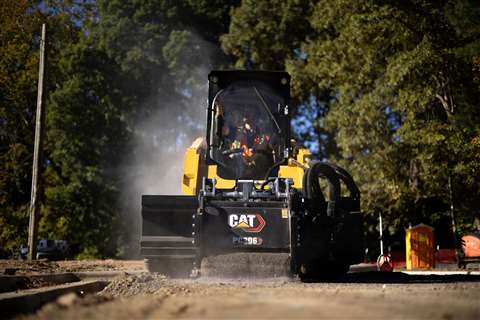 Caterpillar added a smart creep feature to its D3 skid steer loaders and compact track loaders for the operation of cold planers. (Photo: Caterpillar)
Caterpillar added a smart creep feature to its D3 skid steer loaders and compact track loaders for the operation of cold planers. (Photo: Caterpillar)
The company said the system can make new hires productive members of the crew quickly while also reducing stress and fatigue on seasoned professionals. Without the system, the company said setting creep speed too fast can lead to stalling the attachment, and too slow can result in productivity loss.
The operator needs to activate the system and set the maximum creep speed on the in-cab display. Once the tool engages the cut, smart creep measures the load on the attachment and adjusts the drive command automatically. In the event of the cutter jamming, an auto reverse feature changes machine direction to clear the jam.
Targeted for availability in the third quarter of 2022, D3 models will be sold smart creep ready. The sensors and software will also be available as a field kit for older D3 models. It is designed for Caterpillar’s latest generation of cold planers and wheel saws.
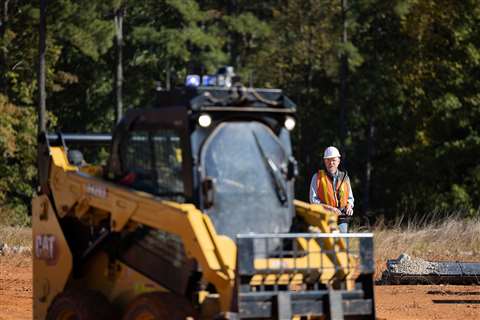 Cat Command remote control will be available in a line-of-sight design with a portable control console for D3 loaders, as well as a non-line-of-sight version. (Photo: Caterpillar)
Cat Command remote control will be available in a line-of-sight design with a portable control console for D3 loaders, as well as a non-line-of-sight version. (Photo: Caterpillar)
Command remote control
Also developed for D3 CTL and SSLs, Cat Command remote control provides joystick-controlled remote operation to increase safety and productivity when operating in challenging and potentially hazardous environments. The technology has already transformed the operator experience in Caterpillar’s larger equipment, including dozers, excavators and wheel loaders.
When it is available in the third quarter of this year, the system will be sold in two configurations: line-of-sight operation with a portable control console and non-line-of-sight operation via a remote control station.
The line-of-sight system includes indicator lights, wireless receiver and antennas installed on the cab roof with an activation switch mounted behind a lockable door with ground-level access. Machine control is made possible through a lightweight console supported by a shoulder harness. Functions such as machine startup/shutdown, bucket rack/dump and lift/lower, horn, creep control, and auxiliary hydraulic functionality are accessed through the console control layout. The operating range is up to 1312 ft (400 m).
The non-line-of-sight Command system adds front, rear and side cameras and a microphone to pick up sound. Controls are integrated with the machine’s electronics, providing users the same control response as operating inside the cab. It also includes a modular, customized station that places users in a seated position that simulates traditional machines. One user can connect to multiple machines of different sizes and types from a single station, controlling one machine at a time – from across town or on the other side of the world.
“The line-of-site solution is designed for customers who want a lower cost solution that gives the ability to operate the machine from outside the cab,” said Kevin Coleman, SSL/CTL product application specialist for Caterpillar. “When you want to get the operator out of the cab for a specific task you can easily do that. Regulatory standards say you have to stop a conveyor before you clean underneath, and that means stopping production. When you take the operator out of that hazardous situation you can maintain your production. And, if needed, the line-of-sight system and the non-line-of-sight system both allow for traditional machine operation from the cab.”
The non-line-of-site Command system represents an investment – in part because of the infrastructure needed to send and receive data. Coleman said adding it to compact loaders will also help customers improve their return on investment.
“Almost every location has a skid steer,” Coleman said. “If you’re going to make the investment in the infrastructure and the Command control station, and you can have a skid steer that you can add to the system, your return on investment is much higher.”
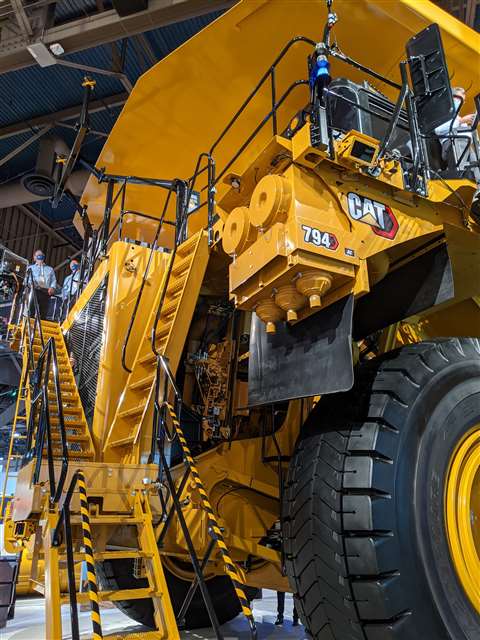 The Cat 794 AC on display during MINExpo 2021 in Las Vegas. (Photo: Chad Elmore)
The Cat 794 AC on display during MINExpo 2021 in Las Vegas. (Photo: Chad Elmore)
Autonomous Haulage Solutions
“I’m humbled to be CTO of a company with such a rich history of innovation,” said Weiss. “And I’m excited to be CTO at a time like this when so much is possible through technology. Our purpose at Caterpillar is to develop solutions that help our customers build a better world. We develop technology to take on their biggest challenges, whether it’s manpower, safety, security, productivity or driving consistency in their operations. That’s what we’re focusing our technology and our solutions on.”
For Caterpillar, its customers buy equipment to do everything from repairing pavement in a subdivision in eastern Iowa to hauling overburden in a Western Australian mine.
“Our engineers live by the mantra, safe and cyber secure by design,” said Weiss, “and there’s great evidence in that because our mining customers have a zero-injury record using our autonomous hauling systems. That is a clear testament to our dedication to helping our customers keep their employees safe. Our customers are clearly more productive using the technology, as well. One of our mining customers in Western Australia has seen a 30% improvement in productivity.
“Those are the quick wins customers can achieve with autonomy, but with the processes we help them put in place they can also drive consistency just like we do in our Caterpillar factories. That consistency gives them better quality, and it gives them the platform from which they can continuously improve year over year. Our customers do not have to end with that 30% improvement but can go beyond because they have a repeatable solution every day.
“Productivity is the ultimate goal of a lot of our customers, especially in the mining business, and many customers also want easier access to work with us and our dealers. That comes together through connectivity. By helping our customers see the bigger picture around their fleets, we allow them to see how much they’re moving and how to optimize overall safety, efficiency and productivity. Even without autonomy, a connected fleet helps our customers know where their machines and people are to improve safety and understand where they have bottlenecks so they can work through them.”
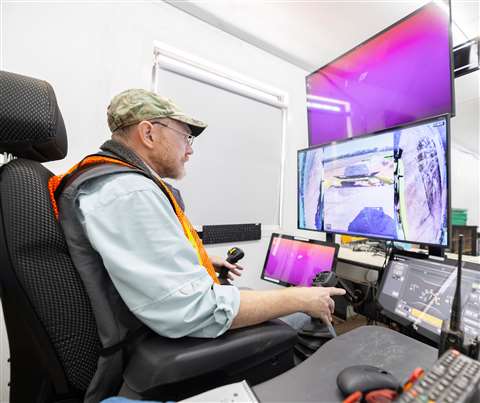 Cat Command remote control provides joystick-controlled remote operation to increase safety and productivity when operating potentially hazardous environments. The technology, such as the non-line-of-site option illustrated here, has already transformed the operator experience in Caterpillar’s dozers, excavators and wheel loaders. (Photo: Caterpillar).
Cat Command remote control provides joystick-controlled remote operation to increase safety and productivity when operating potentially hazardous environments. The technology, such as the non-line-of-site option illustrated here, has already transformed the operator experience in Caterpillar’s dozers, excavators and wheel loaders. (Photo: Caterpillar).
Command for Hauling
One of the company’s biggest examples of ACE in off-highway equipment is the Cat 794 AC electric drive haul truck. In the time since it debuted at MINExpo 2016, the trucks have logged more than 780,000 hours of field operation in fleets working in coal and hard rock in nine countries. The global 794 AC truck population has tripled over the past couple of years to more than 150 units.
Now the 794 AC has become the latest Cat haul truck to be equipped with an autonomous hauling solution, MineStar Command for hauling. The 794 AC is the first electric drive model to join the expanding Command for autonomous haulage fleet, which includes the Cat 789D, 793D, 793F and 797F models. Autonomous 794 AC electric drive mining trucks have already been deployed in South America.
Command for hauling enables total autonomous operating of the trucks, interaction with other equipment, and integration with customer mining processes and systems, all managed by MineStar. It is a complete system integration offered from the factory.
The company said Command addresses many mining challenges, including labor shortages and the demand for higher machine utilization. Autonomous trucks using Command for hauling have surpassed 4 billion tonnes hauled with no lost-time injuries associated with automated truck operation.
“Our approach with autonomy is more holistic to provide standardized solutions,” said Weiss, “to make it easy for our customers and our dealers to support and service the technology. It also gives our customers the ability to tailor the system to meet their unique needs. Our building block approach also enables our machines to rapidly accept this new technology without adding a lot of new components or removing old components that are no longer needed. And that’s our goal to get our customers up and running faster.”
In 2020, Caterpillar acquired Marble Robot, a San Francisco-based technology company.
“When you look at our current product offering and our future in this space, it’s really because of our people that we’ve been able to do the things we’ve done,” said Weiss. “We’ve got a great team, but it’s not just the Caterpillar employees that we have today. It’s the folks that we’ve collaborated with over the years, too. Some of them have become employees and some continue to be partners.
“Marble Robot is a Bay Area startup that was focused on last mile delivery in urban environments. The key technology they had was how to continue to operate a vehicle autonomously when the connection to GPS was lost. In urban environments the tall buildings can block the signal, that also happens on mine sites and construction sites. We’ve brought in that talent to help us solve our customers biggest challenges. It’s a great example of how we brought that Bay Area talent to Cat to help us provide a commercial solution. That’s very meaningful.”
These days, finding and vetting new technology could be considered a full-time job for the CTO and other employees around the world.
“There’s a lot of ways we keep an eye on what’s new,” said Weiss. “We’re involved with a lot of universities and associations. We have a venture capital arm that goes out and scouts through venture capital funds and those connections so that we invest midway through technology development on things that could be beneficial to our business. In that way, we get an early view of what’s happening, and it gives us an ability to partner beyond when those technologies do develop. But there’s so much going on all around the world that it’s a challenge to keep up. That’s another benefit of our global organization – we have people in a lot of different countries that have their ears to the ground on what startups are happening, what funding is being provided by governments that could help accelerate their work, and we tap into those the best we can.”
Much of what has been developed and proven on a mine site finds its way to the rest of the company’s product line – such as the availability of Command on compact equipment.
“Mining has really enabled us to push ahead quickly and forcefully in these technologies,” said Weiss, “but we’ve got customers in other applications, of course. We are leveraging that technology to benefit them, as well. In construction, we’re able to take some of those technologies that we’ve already developed for mining and turn them into solutions our customers with less repeatable applications can leverage. For example, we’re working on automating solar farm installations. You can see a virtuous circle there, where our automation technology is helping install a solar farm, which provides power to the grid that will eventually power our electrified machines in the different sites around the world.”
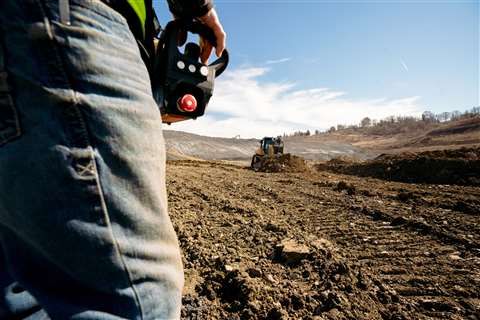 The Command console offers quick transition to line-of-sight machine control at the jobsite through a lightweight, compact console that’s supported by a comfortable shoulder harness. With no on-site communications infrastructure required, it is ideal for temporary or emergency remote operation. Using either a 900 MHz or 2.4 GHz frequency communications protocol, the console offers a machine control range reaching up to 437 ft (400 m). If the remote shutdown switch is pressed, wireless communication is lost, or the console is tilted more than 45 degrees, built-in safety features stop all movement. (Photo: Caterpillar
The Command console offers quick transition to line-of-sight machine control at the jobsite through a lightweight, compact console that’s supported by a comfortable shoulder harness. With no on-site communications infrastructure required, it is ideal for temporary or emergency remote operation. Using either a 900 MHz or 2.4 GHz frequency communications protocol, the console offers a machine control range reaching up to 437 ft (400 m). If the remote shutdown switch is pressed, wireless communication is lost, or the console is tilted more than 45 degrees, built-in safety features stop all movement. (Photo: Caterpillar
Electrified fleet
Autonomy and connectivity will figure heavily into the “e” of ACE – electrification.
In order to extract the maximum value from electrified trucks and other equipment, autonomy will be required.
“When we look at how we assign a truck to go to a loading tool, or go to a dump area, or how we optimize the performance of that value chain, we’re looking at hundreds of variables across that mine site,” said Weiss. “And we use that information to make a decision, whether it’s power availability, congestion or queuing at the dump site or obstruction on the haul road. We use that information to determine what’s the most efficient place to assign that truck, to achieve the production goal of the mine. Today, we can put enough diesel on a truck to operate for 24 hours but with batteries that will not be the case – at least initially. The energy state of the vehicle will become an extremely — if not the most — important variable in determining the assignment for that truck.
“When you combine an electrified fleet with autonomy and connectivity, you can help ensure that that fleet will remain productive without a stranded asset without battery charge. So all of those things come together to make a very powerful solution.”
Written by Chad Elmore, this article originally appeared in the March 2022 issue of Diesel Progress.
STAY CONNECTED




Receive the information you need when you need it through our world-leading magazines, newsletters and daily briefings.
POWER SOURCING GUIDE
The trusted reference and buyer’s guide for 83 years
The original “desktop search engine,” guiding nearly 10,000 users in more than 90 countries it is the primary reference for specifications and details on all the components that go into engine systems.
Visit Now
CONNECT WITH THE TEAM










